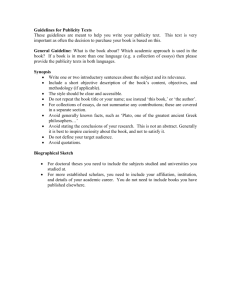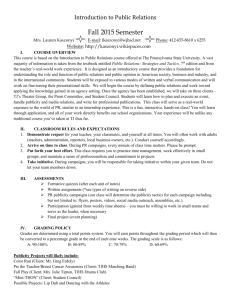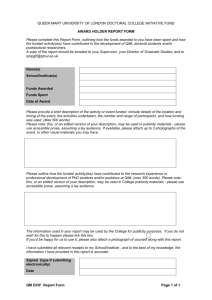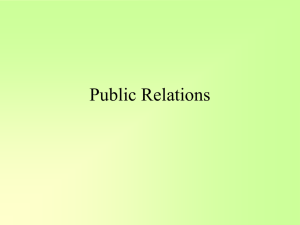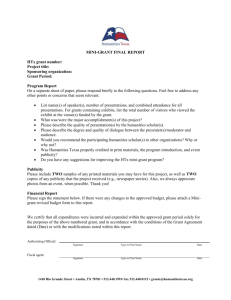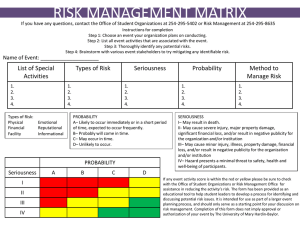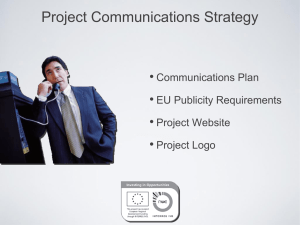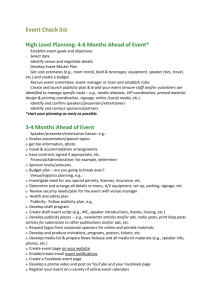guide_for_publicity.doc - Jewish Reconstructionist Community
advertisement
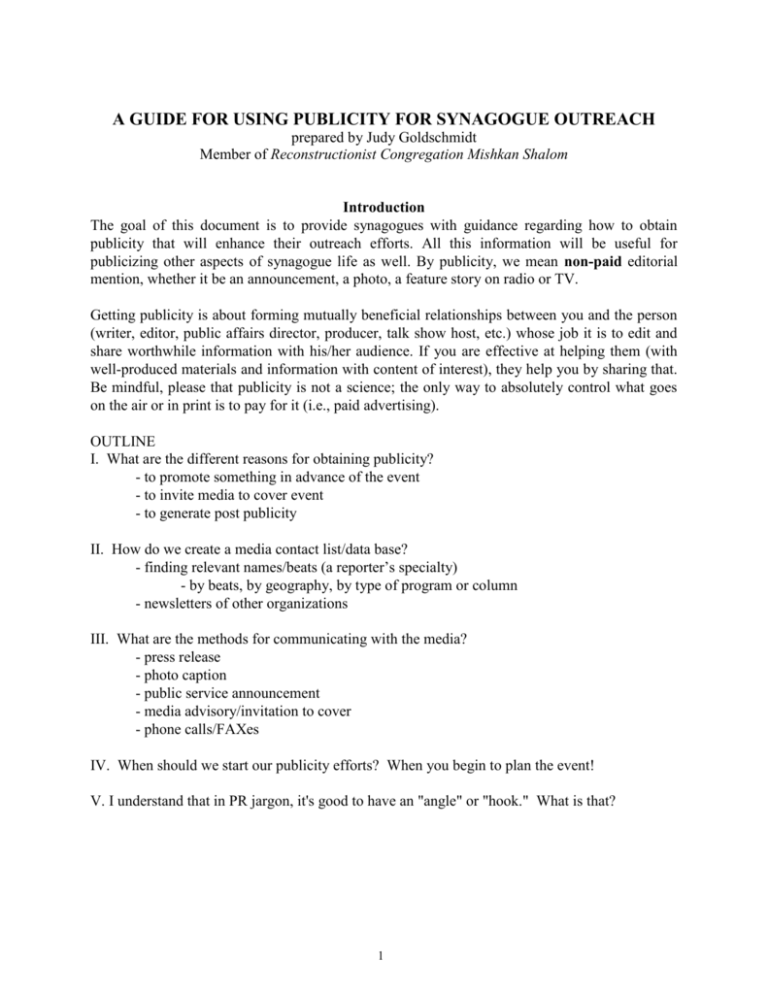
A GUIDE FOR USING PUBLICITY FOR SYNAGOGUE OUTREACH prepared by Judy Goldschmidt Member of Reconstructionist Congregation Mishkan Shalom Introduction The goal of this document is to provide synagogues with guidance regarding how to obtain publicity that will enhance their outreach efforts. All this information will be useful for publicizing other aspects of synagogue life as well. By publicity, we mean non-paid editorial mention, whether it be an announcement, a photo, a feature story on radio or TV. Getting publicity is about forming mutually beneficial relationships between you and the person (writer, editor, public affairs director, producer, talk show host, etc.) whose job it is to edit and share worthwhile information with his/her audience. If you are effective at helping them (with well-produced materials and information with content of interest), they help you by sharing that. Be mindful, please that publicity is not a science; the only way to absolutely control what goes on the air or in print is to pay for it (i.e., paid advertising). OUTLINE I. What are the different reasons for obtaining publicity? - to promote something in advance of the event - to invite media to cover event - to generate post publicity II. How do we create a media contact list/data base? - finding relevant names/beats (a reporter’s specialty) - by beats, by geography, by type of program or column - newsletters of other organizations III. What are the methods for communicating with the media? - press release - photo caption - public service announcement - media advisory/invitation to cover - phone calls/FAXes IV. When should we start our publicity efforts? When you begin to plan the event! V. I understand that in PR jargon, it's good to have an "angle" or "hook." What is that? 1 I. PURPOSES OF OBTAINING PUBLICITY Your goals will determine the right medium for the message. 1. Pre-publicity. Let's assume your goal is to draw people to an event, for educational, outreach and/or fundraising purposes. Advance publicity, then, should be a priority. You have three opportunities here for publicity: sending a press release and having it published as an announcement in print publications and newsletters sending a Public Service Announcement (PSA) that could be used for TV and radio "Community Board" type announcements generating advance feature coverage - such as a radio interview or a feature article in a newspaper consider this example: You are sponsoring a scholar-in-residence. Perhaps you can interest a reporter or talk show host in interviewing your guest in advance to attract awareness and attention to your event. See IV (Contacting the Media) for advance publicity. 2. Day of. Is your goal to have media coverage of an event taking place that people will see/hear/read about on TV/radio/newspapers afterwards? You'll want to issue a media advisory a day or two prior to the event so you can get on assignment desk calendars (When a news shift begins, the producers/editors look at the calendar and make decisions what "news" to cover). You'll want to follow up with phone calls the morning of the day the event takes place, and you'll want to be prepared to FAX the media advisory again to remind them after the call. 3. Is your goal to announce something of interest after an event takes place? Examples abound in Jewish publications. Often this is what we call the "grin-and-grip" opportunity. You get a photo of your award winner with the president, a photo of your guest speaker with the committee chair, etc. and send that following the event with a caption. I suggest you send these post-publicity photos to those publications likely to print them. How do you know? Review an issue! Local interest is also of value here. Chances are your major daily paper won't publish this kind of information. If the major daily was interested in your event, the editor may assign a reporter and/or photographer to cover it. However, your local paper thrives on this kind of information. II. CREATING YOUR MEDIA LIST To begin, you need to think about what media will be most useful to your purposes. Where is your potential market and how do you reach them? geography: determining the media that directly serve your local/targeted audience, as well as the media that serves your synagogue's location. beat: the topic area a reporter specializes in, i.e., Religion Writer, Food Writer. When capturing the names for your list, MAKE SURE YOU ALSO GET FAX NUMBERS AND E-MAIL ADDRESSES WHEN APPLICABLE. 2 1. Weekly Papers Most synagogues are located in an area served by at least one local, weekly paper. This will be your easiest place to send information to and get it in print. It may also be the most effective in reaching out to people in your immediate area. Include local newspapers from surrounding neighborhoods on your list if they serve the geographic area where your potential members are residing. To find out the name of the editor, either get a copy of the newspaper and look up in the editorial box, or look up the name of the newspaper in the phone book and call and ask. Also, browse the weekly papers and see if any particular reporters seem to cover religion-based stories. If so, add that person to the list as well. 2. Specialty Papers/Local Jewish publications. Same as weekly. Find out who handles notices of synagogue activities and/or services and add to your list. 3. Daily Papers For a daily paper, press releases sent simply to "Editor" may not reach the right person. Find out what section of the paper covers Religion and determine the editor of that section for your list. See if any regular columns in the paper might be a place to list an announcement. Include that column in your list. If there is a religion writer for the paper, include him/her on the list as well. 4. TV/RADIO Many local TV & radio stations offer programming matters relating to religion and/or community issues, most often on Sunday AM. You can add these programs to your mailing list, and address your mailing to "Producer." Local talk shows may also be a venue. Do not send everything to your TV/radio list. Do use this list when you are seeking feature stories or want to place a guest on their program. Keep another list for all TV/radio stations with their own news departments. Keep this list for when you want to send out "Media Advisories." Keep a third list for "Public Affairs/Community Affairs Department." To this list you will send Public Service Announcements (PSAs). Also include any local programs on cable stations that serve your geographic area. 5. OTHER LOCAL JEWISH ORGANIZATIONS Don't forget newsletters of other organizations that might print information about what's going on at your congregation. Create a list and address to "Newsletter Editor." I wouldn't expect another congregation to print information to help you with outreach, i.e., print announcements of outreach meetings, but other programming you offer may be promoted, and you may attract affiliated members looking for a better fit! Think of organizations that attract broad support such as JCCs, Jewish singles groups, etc. 6. OTHER FORMS OF PUBLICITY Don't overlook the possibilities of posting flyers in public places that may reach your target market. Notice bulletin boards at such places as: local gyms, libraries, book stores, video stores, 3 grocery stores, coffee houses, etc. Learn at each place what the policy is for posting. (It's not a bad idea to carry your own push pins when installing these flyers.) III. CONTACTING THE MEDIA Now that you have your lists, what should you send and when? 1. A press release is an announcement about something that is going to happen or has happened. Ideally, a press release should be ready to go to the media four weeks in advance to maximize exposure. You should keep a record of deadlines for your regular media contacts. 2. A photo caption is a visual (such as a photo of a guest lecturer) accompanied by concise information that an editor can use in lieu of the press release. Unless the person him/herself is your story, not just part of it, it sometimes helps to send the captained photo a few days to a few weeks after the press release, to get a second opportunity for exposure in print. 3. A PSA has its own format. Write up your information as you would imagine it read on the air -- in 20, 30 and 60 second formats. Read it or have someone else read it and time it. TV and radio stations like to get these at least several weeks in advance. 4. A media advisory/invitation to cover has a specific format to it and is used to invite the media to cover an actual event. You need to determine in advance if this is a situation that is newsworthy to them, and important to you. For example, you may invite a well-known VIP to speak at Shabbat services, but do you want reporters and/or TV cameras disrupting a religious service? An invitation to cover is very "immediate." For a weekly paper, a few days in advance is preferable so that the editor can line up a reporter and/or photographer to cover. In a TV studio, the assignment desk usually doesn't make decisions on news stories until that day, so sending it two days in advance to TV is usually not effective. 5. Phone Calls/FAXES . If obtaining this coverage is important, and you think there is valid media interest, it can be very helpful to follow up media advisories with calls to assignment editors early in their shift. Be prepared to FAX the information again upon request. IV. MAKING PUBLICITY AND PROMOTION PART OF THE PLANNING When you begin to plan an event or campaign, how you can use publicity to your advantage should be considered up front, not as an afterthought. For example, suppose you invite a VIP to address your congregation at a Shabbaton and to attend a New Members Brunch on Sunday. You want to use this opportunity to attract non-members. You would also like to educate the public at large about Reconstructionist Jewry via possible media story placements. In this example, here are some factors that may come up: Does your synagogue care if you invite reporters and/or TV cameras to services? If so, you don't want to invite the media to cover. The ability to attract media attention to an event taking place over a weekend can be more difficult, because the media often schedules less staff on the weekends. 4 Sunday AM TV/radio public affairs programs may be interested in interviewing this VIP. If you consider these factors up front, you open the door to more opportunities. For example: You will know to ask your guest in advance for his/her biographical materials and photo in advance. You will know to make duplicates of the photo in advance and budget that expense as part of your event planning. You may ask the VIP for some scheduling flexibility that will allow you to make him/her available to be interviewed by members of the media, i.e., you may be able to line up an appearance on a Sunday public affairs show or an advance phone interview for a radio show. V. ANGLES Getting free feature publicity can be like a fishing expedition. An angle or hook is what you "feed" the media (an assignment editor, a TV producer) to help them find a new, visual or otherwise interesting perspective to your story -- worthy of reporting/sharing with a larger audience. If your goal is to attract pre-event feature coverage, evaluate what the angles are to your event. Put yourself into the shoes of the editor or producer; see what their products (their columns, their beat, their talk shows, their public affairs program) are like and if your story may fit. If you are unsure about finding good angles, brainstorm with marketing people you know, and talk with the editors, producers. In my experience, most have been very helpful. Here's a true story about finding an angle that was so "hot, so immediate," and of such regional and national import that my job was actually made easy: In September 1993, two days before Yassir Arafat and Yitzchak Rabin were to sign the historic peace agreement in Washington, DC, twenty progressive Jewish Middle-East peace activists from the US were invited to come to the ceremony as witnesses. On Saturday night after Shabbat, my rabbi, Brian Walt, called me to tell me that he and four others from my synagogue, Mishkan Shalom, and our neighborhood were invited, and did I think the media would be interested? This was major news, and I did not even have to write a press release or send a FAX. On Sunday morning, I called all the Philadelphia TV news stations and major daily papers, and by the afternoon, camera operators, reporters and photographers were in Mt. Airy interviewing Brian and the others for the Sunday evening news. 5
